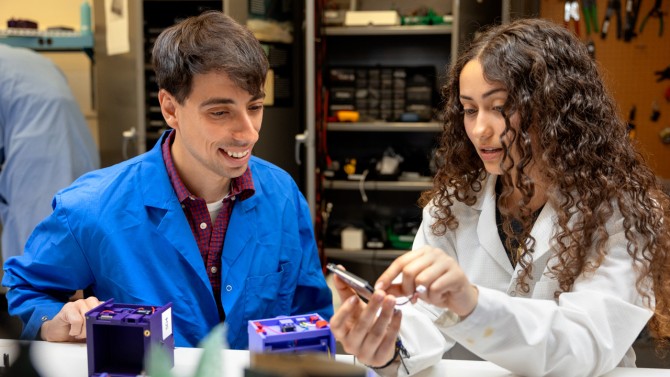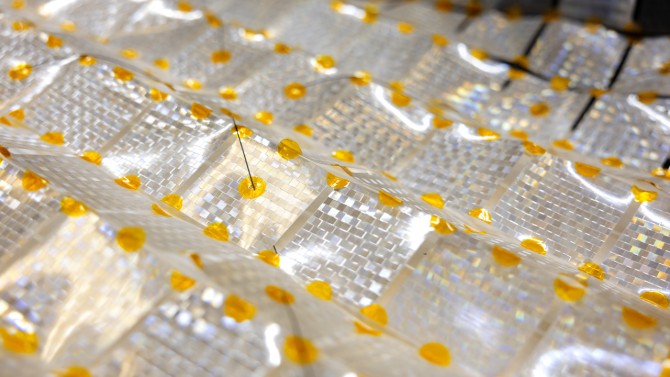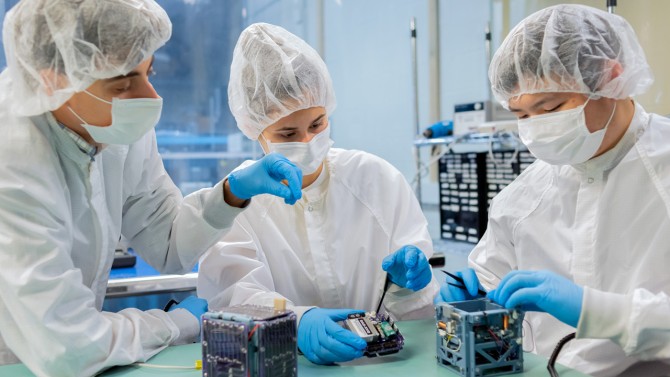Student-designed technology bound for space station
By David Nutt, Cornell Chronicle
What does it take to get a small student-built satellite to the International Space Station so it can be tested in orbit?
Eight years. More than 120 undergraduates. Industry collaborators. And a lot of glue.
This fall, Alpha CubeSat is scheduled to be rocketed to the ISS. It’s not the only space-bound student experiment. Also launching to the ISS, in late summer, is a related project, Sailing to the Stars, in which six light sails that could one day propel small spacecraft through interstellar realms will be tested in microgravity.
Both projects emerged from Cornell’s Space Systems Design Studio (SSDS), led by Mason Peck, the Stephen J. Fujikawa ‘77 Professor of Astronautical Engineering in Cornell Engineering.
“These space-technology experiments take fundamental research into orbit, elevating new ideas beyond mere paper studies and proving they work,” Peck said. “It’s rare enough for a student to be able to launch their senior project, but Cornell may be unique among U.S. universities in how we introduce students to game-changing technology research as experiential learning.”
CubeSats are low-cost, modular satellites the size of a shoebox, or smaller, that can be custom-tailored to meet a host of technical requirements for different types of missions. One such mission: deploying light sails, poster-size sheets of microprismatic retroreflective film that are origami-folded inside a deployer, then pop out like a jack-in-the-box and float off to distant planets or star systems. The sails can be equipped with chip-sized satellites – aka “ChipSats” – to transmit data to Earth.
The Alpha CubeSat concept was proposed in 2016 by Isabel Dawson ’23, then a sophomore at Ithaca High School. After being inspired by a lecture Peck gave at her school, she led an IHS team to win an international CubeSat design competition. The team was paired up with a group of Cornell students to turn that design into a functioning satellite.
“They got pretty far,” said Joshua Umansky-Castro, a doctoral student in aerospace engineering, who joined the project in 2019. “But as you can tell, they didn’t quite finish it that year.”
As the years came and went, so did several generations of engineering students who contributed to Alpha. By the time the pandemic struck, the original team had dispersed, and membership dwindled. Umansky-Castro ended up spending six months redesigning the circuitry from his bedroom.
“During that time, I learned everything from the ground up,” he said. “And when the campus reopened, we started redesigning everything, getting the electronics to work, getting a whole new ChipSat designed. Even the sail had to be modified.”
While Umansky-Castro oversaw the hardware development, Lauren Greenhill ’24 handled the software. She rewrote the programming during her freshman winter break and then spent the next three-and-a-half years leading a team of students to get the source code tested and flight-ready.
Now that Alpha’s terrestrial time is almost up, Greenhill is amazed by how far the project has come.
“I had some robotics experience in high school, but it was really exciting to get to work on an actual spacecraft and do research that I thought was really meaningful,” she said. “Alpha has been the most important part of my Cornell experience.”
‘Wait a second, I can’t leave the lab’
The students had plenty of help along the way, including the longtime mentorship of Silicon Valley engineers Andrew Filo, whose contributions include designing the light sail, and Alex Burke, who shared best practices for circuit and software design. The Avery-Dennison Corporation provided the light sail material, and Houston-based Voyager Space (formerly NanoRacks) helped facilitate the NASA safety approvals needed for the technology to fly onboard the space station.
In March, Alpha was packed up and delivered following an arduous monthslong push to get everything finished in time. The final work on Alpha’s hardware was particularly grueling.
“It was definitely crazy,” Umansky-Castro said. “There was a point I started calculating how many hours I had left and realized, wait a second, I can’t leave the lab. So from Sunday to Friday, I never left. I just kept working, one step at a time, taking power naps while glue was drying. And then after all that, I still had to drive 24 hours to bring the satellite to Texas. My parents helped with that.”
The stress isn’t over. When the astronauts release Alpha into space, the student team will try to communicate with the satellite through an Iridium modem connection as it periodically sends basic spacecraft health data down to Earth. Alpha will also perform a few technical demonstrations, such as spin stabilization. After 24 hours, when Alpha is a safe distance from the space station and the student team receives clearance from NASA, they will send a series of three commands and order the CubeSat to deploy a SSDS light sail.
Then the students will wait to receive sensor readings that confirm the deployment, as well as data from four ChipSats that are installed on the sail. That data will be relayed via a low-power, long-range technology collected by Tiny GS – short for tiny ground station – which is an open-source global satellite network that essentially allows thousands of backyard astronomers to listen to satellites.
“We’ll have all these listeners around the world trying to hear those ChipSats in a two-day time period to see if they’re alive and working,” Umansky-Castro said. “We are as prepared as we could ever be, but there’s still anxiety. I put in years of my life testing this and getting to the point where it’s flight-ready. There’s still that feeling of, ‘Is it really ready?’ Especially when it’s in orbit. 100 things have to go right. If one of those things goes wrong, the mission’s over.”
Atmospheric drag will eventually force Alpha and the light sail from orbit and they will burn up upon reentry into the atmosphere. However, if all goes as planned, their spirit will live on in the data that the students collect. The findings may inform other projects in the SSDS pipeline, such as DeSCENT, which will release 100 ChipSats at an altitude of 100 kilometers to better understand how the tiny satellites disperse as they fall. SSDS is also developing ChipSats for the lunar surface and surviving atmospheric entry and possibly monitoring livestock.
Even after Alpha has been reduced to cinders, Umansky-Castro will continue his involvement in ChipSat design, as a postdoc or an independent consultant.
“It’s been a dream of mine to send something into space,” he said. “And I’m so thankful to have this opportunity at Cornell to do it and to share that experience with all these students who also want to do the same thing.”
‘What exactly is going on there?’
Compared to Alpha CubeSat, the development of Sailing to the Stars has been relatively speedy. Verena Padres ’26, a mechanical and aerospace engineering student, worked on Alpha’s integration testing team as a freshman, and in the fall of 2023 she became the project lead for Sailing to the Stars. Two years later, the light sails and deployers are launch-ready and NASA-approved, a remarkable feat that is testament to team effort, discipline, hard work and Padres’ strong leadership, according to Umansky-Castro.
“I don’t think Verena would ever mention it herself, but I will brag for her,” he said. “Most of the projects in our lab’s 20-year history have taken years.”
Like Umansky-Castro, she and her team spent many late nights in the lab making last-minute tweaks before shipping the light sails to their industry partner, Rhodium Scientific, in Houston in May. Six sails will be tested, as will two different deployers: one that mimics Alpha CubeSat, and one with a new, possibly more stable design. Unlike traditional CubeSats, these deployers use laptop hard drives to spin and generate the necessary angular momentum for deployment. The astronauts will set up a pair of video cameras to capture the hour-long experiment. Padres and her team expect to be in communication with the astronauts during the tests, in case there are any questions about the procedures or hardware. Afterward, the students will receive the video footage and the CubeSat’s sensor data to review and see what they can learn.
“What does the sail look like coming out? Is it tumbling? Is it wobbly? Is it not open all the way? What exactly is going on there?” said Padres, a passionate space enthusiast who previously interned at NASA’s Jet Propulsion Laboratory. “If you better understand how the light sail comes out, then you can understand what to do with it.”
The light sails are out of the lab, but Padres is not quite finished with them. Four days before the launch to the ISS, she and several teammates will fly to Florida and get one last moment with their hardware to do final testing, check the battery voltage, tighten the screws and secure the sails.
For now, she is waiting and, like Umansky-Castro, contending with the pre-launch jitters.
“It’s not quite done yet,” Padres said, “but definitely these are more fun times than sitting there, trying to wait for epoxy to dry at 11 p.m.”
Media Contact
Get Cornell news delivered right to your inbox.
Subscribe




